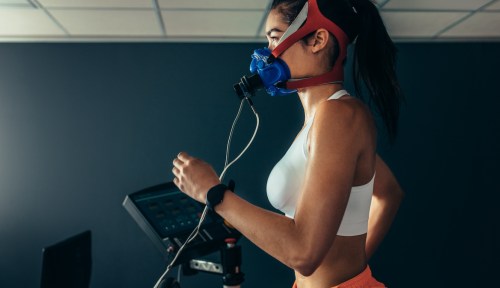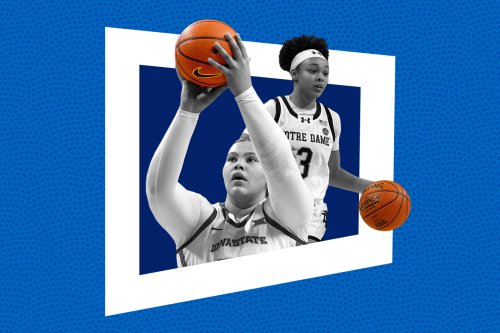Why There’s Such a Big Gap in Women’s Sports Performance Research—And What’s Being Done About It
Women's sports performance research is rare. These female researchers are working to change that with studies by and for women.

The next time someone gives you advice based on a “recent study” or “scientific research,” ask that person: How many of the subjects of that study were female?
Experts in This Article
injury prevention researcher, sports medicine specialist, and fitness trainer
exercise physiologist and nutrition scientist
“It’s commonly known in the scientific community that women are underrepresented in research,” says Liz Letchford, PhD, ATC, a doctor of kinesiology and rehabilitation science whose dissertation research comprised methods of detecting injury risk in female athletes.
Just how underrepresented, you ask? Within sports and exercise medicine, women make up less than 40 percent of research subjects. Narrowed specifically to sports performance research—aka science looking at athletic optimization, training, and injury prevention—Science News found that out of 30 recent studies (excluding one specifically focused on sex differences in marathon pacing) women made up a—wait for it—mere 3 percent of participants. Despite the fact that these bodies account for half the population (in sports and elsewhere).
“I went to three universities: for a bachelor’s in athletic training, a master’s in kinesiology and health and movement sciences, and finally my PhD,” says Dr. Letchford. “I was heavily involved in the research process [at each university], and it was nearly always advised to use male subjects within the study design, because female subjects have a ‘confounding variable.’”
That confounding variable, naturally, is the menstrual cycle, which adds an extra layer of complexity to any kind of research looking at the body. A paper published in the International Journal of Sport Nutrition and Exercise Metabolism earlier this year explains that the “physiological intricacy” of the female body “necessitates more complex study designs, longer research times, and additional costs,” and that most sports science and medicine “practices are based on research with men, despite potential problems in translation to females.”
Which means female bodies could suffer due to a lack of knowledge.
Dr. Letchford notes that while the hormonal fluctuations of a monthly cycle are not without their challenges, they’re more predictable than the scientific community has made them out to be. In fact, current data suggest that 75 to 86 percent of women have regular periods.
But the fluctuations can still lead to results that appear skewed on the surface. “Dr. Stacy Sims talks about this a lot,” says Dr. Letchford, referencing the trailblazing exercise physiologist and nutrition scientist specializing in sex differences (who gave this TED Talk). Dr. Sims highlights how there’s a lot of “convenient data cleaning” in labs that throws out outliers beyond the known average—which could in fact be where we find major revelations. “Outliers may actually have the information we need to heal and help women,” says Dr. Letchford.
Women face barriers on both sides of the lab
Dr. Sims, who formerly directed research programs at Stanford, as well as Auckland University of Technology and the University of Waikato in New Zealand, has published over 70 peer-reviewed papers and is referred to as the “biohacker for the female race.” Currently, she is trialing a program in New Zealand where she’s designed a rehab specifically for women recovering from ACL surgery based on the timing of their menstrual cycle.
But her origins in the lab started in her undergraduate studies. As a participant in research at Purdue University, Dr. Sims notes that she was one of the only women who’d volunteer to take part in the metabolism labs. “The language used in sport-science recruitment is often very masculine and aggressive, which plays havoc with women’s confidence in being a good participant,” she says. Once, when her results on a study that looked at carb and fat oxidation were different from those of the men, the team claimed she didn’t do the experiment properly and threw out her results.
“By design of the study, I, as a woman, was going to be different,” she says.
She adds that women are typically only used in trials if they’re on oral contraceptive pills to minimize hormonal effects. “But this is also [BS] because oral contraceptives are experimental in their own right,” Dr. Sims says.
The gap in women’s sports performance research might be smaller if the gap in researchers was smaller as well: Less than 30 percent of the world’s researchers are female.
Ingrained cultural stereotypes and gender biases, as well as outright sexism, are commonly known to keep women out of labs. “Showing up as a woman” is a barrier, says Dr. Sims, noting examples such as mansplaining incidences (including a man “citing studies to me that were actually my publications”) to being told by a male boss that her problem was that she was “a woman with a PhD that thinks too much.” In 2020, Rita Colwell, PhD, gave a searing account in The Atlantic of her experience as a microbiologist over the span of six decades. “Carol A. Nacy, a former president of the American Society for Microbiology, has been mistaken for a secretary four times in recent years while making pitches to venture capitalists for three companies she founded,” Dr. Colwell wrote.
Gold Medal Couple Tara Davis-Woodhall and Hunter Woodhall Talk Marriage, Motivation, and Their Next Chapter With Nike

Coach Kara Lawson Wants You to ‘Handle Hard Better’—and Here Are 3 Ways to Do Just That

JuJu Watkins Leaves March Madness With ACL Tear—and This Knee Injury Is More Common Than You Think

And where there’s sexism, there’s often sexual harassment and assault. Dr. Letchford says that she’s personally faced sexual harassment in “nearly every research and teaching position, nearly every clinical athletic training job” she’s ever had. Data on STEM fields reveals that the culture is rife with assault and abuse.
Funding discrepancies don’t help, either. Men almost always receive more money for their research than their female counterparts—over 30 percent more on average.
This absence of women in the labs directly leads to a lack of women’s research. “Something that I’ve noticed, generally, is a lack of curiosity around anything outside of one’s own lived experience,” Dr. Letchford says.
It’s a chain reaction. If people aren’t asking questions about women’s experiences, no one will study those experiences. “If we don’t have studies, then we don’t have data, and if we don’t have data, that leads to problems with healthcare,” says Dr. Letchford. Women end up facing issues getting treatment or coverage for “these real medical issues that simply haven’t been studied.”
“If we don’t have studies, then we don’t have data, and if we don’t have data, that leads to problems with healthcare.” —Dr. Liz Letchford
Research backs up her theory. Women are, in some instances, at higher risk for life-threatening health problems because they’re under-diagnosed. “There are subtleties that we’re missing; subtle signals of the female body that often get overlooked in medicine,” Dr. Letchford says, referencing the difference in heart attack symptoms of men and women—which makes women more likely to have a fatal heart attack. Outside reports that “eight of the 10 prescription medications that were pulled from the market between 1997 and 2000 were removed because of adverse effects for women.”
Changing the narrative around women’s sports performance research
The good news? Although they remain in the minority, today there are several female researchers who are making noise for women.
This January, Stanford University launched Stanford FASTR: Female Athlete Science and Translational Research. The program’s goal? “To help close the gender gap in sports science research.” FASTR is led by Emily Kraus, MD, and Megan Roche, MD, two doctors and researchers who’ve spent the majority of their careers focusing on female athletes. According to a recent story in Outside, their projects will identify injury risks, intervene with screening tools, and create plans for athletes that involve fuel, recovery, mental health, and injury prevention.
Injury is a big theme across the board; existing research already has indicated that injury risk is different for male and female athletes. Dr. Letchford began her doctoral research on the subject a decade ago, specifically on identifying risk factors for ACL injury in female athletes. “I wanted to create a more robust tool for athletic trainers, physical therapists, and coaches to screen lower extremity injury risk,” she says. (Knees, apparently, are the bane of many female athletes’ careers.)
The FASTR program is currently teaming up with the Female Athlete Program in the Sports Medicine Division at Boston Children’s Hospital, which is directed by sports medicine physician and endocrinologist Kathryn E. Ackerman, MD, MPH. With over 80 published papers addressing sex discrepancies in this field, Dr. Ackerman’s work focuses on amenorrhea and menstrual dysfunction, as well as injury risk. Notably, in 2021, she addressed menstrual dysfunction in an assigned-female-at-birth transgender teen athlete.
And instead of ignoring the female body, today, there are researchers leaning into hormonal research. One of the leaders in that area is Kirsty Elliott-Sale in the United Kingdom, who’s examined the effects of female reproductive hormones on muscle strength.
Then there’s the femtech field. “The recent tracking apps that have included menstrual cycle status—and what to do with each phase—is a huge jump forward,” says Dr. Sims. She notes that while there is still “quite a bit of work to be done to get algorithms appropriate for the female body” on fitness apps, funding in this area is becoming more prolific.
Fortunately, the curiosity propelling this work forward doesn’t seem to be fading anytime soon. Dr. Sims points to the work of her “very smart PhD students” like Natalie Hardaker, who is researching sex differences in concussion recovery and Emma O’Loughlin, whose focus is sex differences in ACL rehabilitation.
Next up: Researching women’s sports and emotional health
Something else to look forward to in this area? A focus on mental and emotional health. Dr. Kraus and Dr. Roche have made that a core component of Stanford’s FASTR program. Dr. Letchford shares that her latest project connects her ACL dissertation to a woman’s emotional experience, assessing potential causality.
“One major cause of ACL injury is often pelvic and hip instability,” she says. “I have a hypothesis that there might be an emotional component involved in a person’s ability to activate these muscles. So if women are having difficulty connecting to their pelvic floor—for reasons that are mechanical, physical, emotional, or spiritual in nature—this could lead to pelvic instability that may in turn lead to ACL injury.”
“You cannot treat any body—especially a female body—without understanding everything going on in the biopsychosocial-spiritual model of healthcare,” says Dr. Letchford.
Luckily, we are finally seeing more of the research necessary to give us a better understanding of what is actually going on inside the female body from many different angles.
“I am hopeful, finally, after 20-plus years of thinking I am pushing against a brick wall,” says Dr. Sims. “Just in the past three-ish years, we have seen an explosion of female-centric research, empowerment, and conversations; scientific design is improving, female environments are becoming more evident.”
Citing more conversations and research on the topics of puberty and menopause, she says there’s immense hope, and immense potential for the next generations of women. “My main drive right now is to push the boundaries and dogma so that my daughter and her friends have a more positive sport and health environment—one that is empowering.”
Oh hi! You look like someone who loves free workouts, discounts for cutting-edge wellness brands, and exclusive Well+Good content. Sign up for Well+, our online community of wellness insiders, and unlock your rewards instantly.
Sign Up for Our Daily Newsletter
Get all the latest in wellness, trends, food, fitness, beauty, and more delivered right to your inbox.
Got it, you've been added to our email list.







